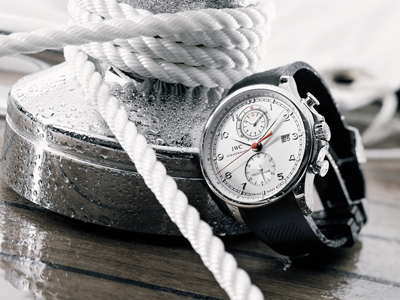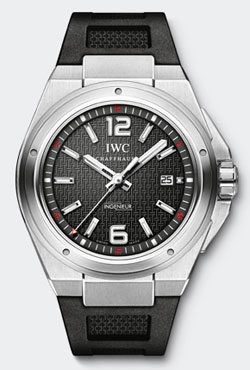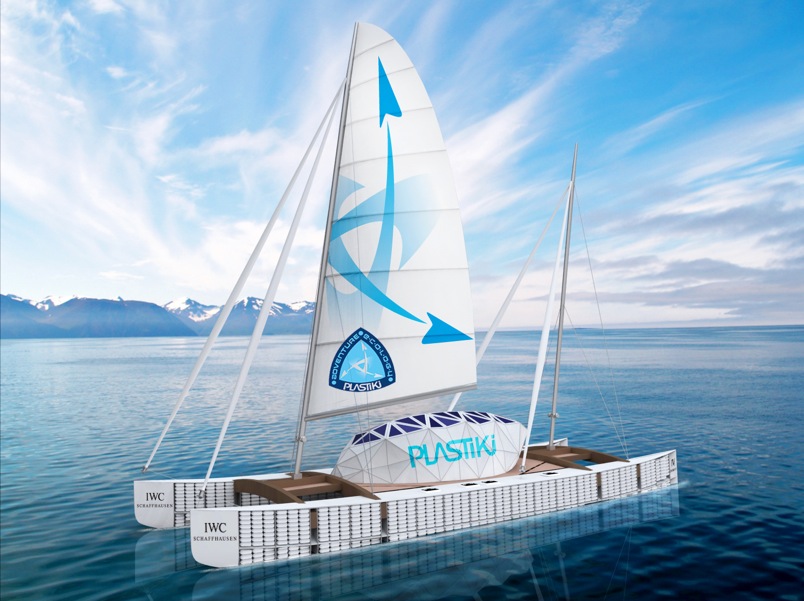|
 No other men's wrist watches from the Swiss IWC do not have won the company a reputation for technical expertise as much as the first «Ingenieur», launched into a series in 1955. They feature an automatic movement which was placed in an additional to soft iron inner case for protection against magnetic fields. A giant leap from manual to automatic winding were made four years earlier with the then revolutionary movement IWC of caliber 85 with central seconds hand, whose origins date back to 1940 years. But only in 1955 a series of IWC Ingenieur able to put in the vanguard of the race of Swiss manufacturers who were trying to create the first bi-directional automatic action mechanisms. The winding system in a line of 85-gauge, based on the oscillating rocker and roller was developed technical director Albert Pellatonom and set new standards in design of watches. No other men's wrist watches from the Swiss IWC do not have won the company a reputation for technical expertise as much as the first «Ingenieur», launched into a series in 1955. They feature an automatic movement which was placed in an additional to soft iron inner case for protection against magnetic fields. A giant leap from manual to automatic winding were made four years earlier with the then revolutionary movement IWC of caliber 85 with central seconds hand, whose origins date back to 1940 years. But only in 1955 a series of IWC Ingenieur able to put in the vanguard of the race of Swiss manufacturers who were trying to create the first bi-directional automatic action mechanisms. The winding system in a line of 85-gauge, based on the oscillating rocker and roller was developed technical director Albert Pellatonom and set new standards in design of watches.
In the series of The Yacht Club and the Ingenieur SL in the 1960s and 70s can be upgraded to see 8541 and 854 calibers (which includes the date and without it), which were more reliable. Movements of The Yacht Club were even equipped with a suspension system on the soft rubber buffers. Since 1976, 8541ES-caliber progressive development company, has been used in IWC Ingenieur SL (ref/1832). These watches are still in great demand among collectors today. Their unusual shape has become a hallmark of all subsequent models in the line Ingenieur: five well-defined holes in the bezel, dial design in the style of "graph" (projecting paper) and the zipper on the logo. When the IWC made the first clock Ingenieur Titanium (ref.3350) in an ultra thin titanium case in the early 1980s, they also created a furore. In 1989, IWC introduced a Ingenieur (ref.3508) with protection against magnetic fields up to 500,000 amperes per meter, which can withstand even the resonant oscillations of the magnetic imager.
In 2005, the chronograph Ingenieur, one of the most famous watches IWC, said the return of the loud-engineering in its purest form, the embodiment of the clock. A new generation has stood the test of vibration, shock resistance and resistance to magnetic fields that are currently emitted by virtually all mechanical equipment. With a very large caliber 51 113, equipped with the factory system Pellaton, which has a seven-day power reserve, Ingenieur in stainless steel created a furore when it was launched in 2007. A year later, IWC Ingenieur released in platinum and rose gold versions.
At the time, as pilot's watches IWC drew drew .jpg) inspiration from the heavenly smooth surface, the line Aquatimer - from the ocean, Ingenieur series originates from the ground. So the name of our planet is not in vain consumed in hours «Ingenieur Automatic Mission Earth» (Ingenieur Automatic Mission Earth). For adherents of precision mechanical watches are also available Big Ingenieur Chronograph with analog display for extended recording time, and the tachometer scale. Perhaps more than any other family watches from IWC, the name Ingenieur embodies overstrength even in extreme conditions and a passion for nature, combined with a thirst for adventure. Therefore, one of the adventurers and environmentalist David de Rothschild IWC has entered a long-term partnership. Adventures for ecologists to help a new look at the world and relying on them, to inspire, educate and involve people, institutions and industry in order to move towards a more rational and careful use of natural resources. In 2009, IWC paid tribute to the partnership, releasing limited edition Ingenieur Automatic Mission Earth Edition "Adventure Ecology". And in 2010, David de Rothschild and his team were equipped with these reliable watches in a difficult journey across the Pacific for four months. The team looked for ways of solving the myriad of environmental problems on board the "Plastiki" - a catamaran, which consists of 12 500 melted plastic bottles. It was equipped with a sail of processing high-tech material, as well as solar panels, wind turbines and bicycle-powered generators to provide "Plastiki" electricity. The task of the expedition was to draw public attention to the damage we inflict thoughtless nature. inspiration from the heavenly smooth surface, the line Aquatimer - from the ocean, Ingenieur series originates from the ground. So the name of our planet is not in vain consumed in hours «Ingenieur Automatic Mission Earth» (Ingenieur Automatic Mission Earth). For adherents of precision mechanical watches are also available Big Ingenieur Chronograph with analog display for extended recording time, and the tachometer scale. Perhaps more than any other family watches from IWC, the name Ingenieur embodies overstrength even in extreme conditions and a passion for nature, combined with a thirst for adventure. Therefore, one of the adventurers and environmentalist David de Rothschild IWC has entered a long-term partnership. Adventures for ecologists to help a new look at the world and relying on them, to inspire, educate and involve people, institutions and industry in order to move towards a more rational and careful use of natural resources. In 2009, IWC paid tribute to the partnership, releasing limited edition Ingenieur Automatic Mission Earth Edition "Adventure Ecology". And in 2010, David de Rothschild and his team were equipped with these reliable watches in a difficult journey across the Pacific for four months. The team looked for ways of solving the myriad of environmental problems on board the "Plastiki" - a catamaran, which consists of 12 500 melted plastic bottles. It was equipped with a sail of processing high-tech material, as well as solar panels, wind turbines and bicycle-powered generators to provide "Plastiki" electricity. The task of the expedition was to draw public attention to the damage we inflict thoughtless nature.

|
